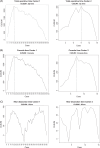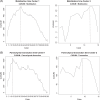The learning curve for robotic living donor right hepatectomy: Analysis of outcomes in 2 specialized centers
- PMID: 39441028
- PMCID: PMC11732260
- DOI: 10.1097/LVT.0000000000000480
The learning curve for robotic living donor right hepatectomy: Analysis of outcomes in 2 specialized centers
Abstract
Robotic surgery is an emerging minimally invasive option for living donor hepatectomy. Currently, there are no studies on the learning curve of robotic donor hepatectomy. Thus, we evaluated the learning curve for robotic donor right hepatectomy. We retrospectively reviewed prospectively collected data from consecutive living donors who underwent robotic hepatectomy at 2 specialized centers between 2016 and 2022. We estimated the number of cases required to achieve stable operating times for robotic donor right hepatectomy using cumulative sum (CUSUM) analysis. The complication rates were similar between the 2 centers (22.8% vs. 26.7%; p = 0.74). Most complications were graded as minor (70.4%). Analysis of the total operative time demonstrated that the learning curves reached a peak at the 17th case in center 1 and the 9th case in center 2. The average operation times for cases 1-17 versus 18-99 in center 1 were 603 versus 438 minutes ( p < 0.001), and cases 1-9 versus 10-15 in center 2 were 532 versus 418 minutes ( p = 0.002). Complication rates were lower after the learning curves were achieved, although this did not reach statistical significance. A comparison of outcomes between centers suggests that a standardized approach to this complex operation can be successfully transferred.
Copyright © 2024 The Author(s). Published by Wolters Kluwer Health, Inc.
Conflict of interest statement
R. Mark Ghobrial consults for TransMedics. The remaining authors have no conflicts to report.
Figures




References
-
- Cherqui D, Ciria R, Kwon CHD, Kim KH, Broering D, Wakabayashi G, et al. . Expert consensus guidelines on minimally invasive donor hepatectomy for living donor liver transplantation from innovation to implementation: A joint initiative from the International Laparoscopic Liver Society (ILLS) and the Asian-Pacific Hepato-Pancreato-Biliary Association (A-PHPBA). Ann Surg. 2021;273:96–108. - PubMed
-
- Rho SY, Lee JG, Joo DJ, Kim MS, Kim SI, Han DH, et al. . Outcomes of robotic living donor right hepatectomy from 52 consecutive cases: Comparison with open and laparoscopy-assisted donor hepatectomy. Ann Surg. 2022;275:e433–e442. - PubMed
-
- Broering DC, Elsheikh Y, Alnemary Y, Zidan A, Elsarawy A, Saleh Y, et al. . Robotic versus open right lobe donor hepatectomy for adult living donor liver transplantation: A propensity score-matched analysis. Liver Transpl. 2020;26:1455–1464. - PubMed
-
- Chen PD, Wu CY, Hu RH, Ho CM, Lee PH, Lai HS, et al. . Robotic liver donor right hepatectomy: A pure, minimally invasive approach. Liver Transpl. 2016;22:1509–1518. - PubMed
-
- Ciria R, Berardi G, Alconchel F, Briceño J, Choi GH, Wu YM, et al. . The impact of robotics in liver surgery: A worldwide systematic review and short-term outcomes meta-analysis on 2,728 cases. J Hepatobiliary Pancreat Sci. 2022;29:181–197. - PubMed
Publication types
MeSH terms
LinkOut - more resources
Full Text Sources
Medical

